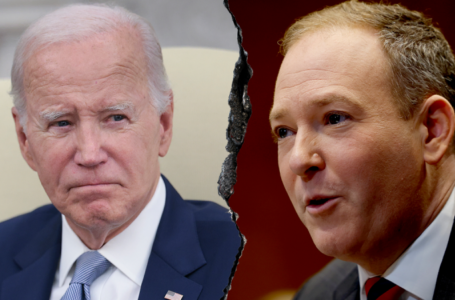GOP moves to defund hospitals that perform sex-change procedures on minors
Is gun violence the leading cause of death for children?


“Gun violence is the leading cause of death of children.”
— White House news release, Jan. 25
“Gun violence is the leading cause of death of the children of America — leading cause of death — not car accidents, not some form of cancer — gun violence.”
— Vice President Harris, remarks at the U.S. Conference of Mayors, Jan. 19
Deaths from gun violence, after remaining relatively stable from 1999 to 2014, have spiked in recent years, to a peak of 48,830 in 2021, according to data maintained by the Centers for Disease Control and Prevention. But has gun violence become so horrific that it is now the leading cause of death for children?
The Biden White House, in various venues, has made that claim. But the source cited in the White House news release — a 2022 study by the Center for Gun Violence Solutions at Johns Hopkins University — reports data with a broader focus. It cites gun deaths of “children and teens,” meaning it includes deaths of 18- and 19-year-olds, who are legally considered adults in most states.
When you focus only on children — 17 and younger — motor vehicle deaths (broadly defined) still rank No. 1, as they have for six decades, though the gap is rapidly closing. Indeed, deaths of children from gun violence have increased about 50 percent from 2019 to 2021, the CDC data shows. During the coronavirus pandemic, there was a surge in firearm sales and an increase in the use of firearms in deaths by suicide — especially among children in rural areas.
There’s no question that 18 and 19 signify the final years of being a teenager, but there is also broad agreement around the world that 18 is a threshold age between being a child and adulthood.
The National Institutes of Health, for grant applications, defines a child as “an individual under the age of 18 years.” The European Union has a similar definition. The United Nations, in the 1989 Convention on the Rights of the Child, says “a child means every human being below the age of eighteen years.”
All but three states set the age of majority at 18. Alabama and Nebraska set it at 19, while Mississippi sets it at 21. In the United States, one earns the right to vote and the right to join the military at the age of 18.
Moreover, federal law permits the purchase of shotguns and rifles — including semiautomatic weapons — at the age of 18. Twenty-two states have set the minimum age for buying a rifle at 21, according to Everytown for Gun Safety — the same minimum age for buying a handgun.
For the purposes of this fact check, the fact that in more than half the states people as young as 18 can purchase firearms is significant, because access to firearms increases the risk of violence. Six years ago this month, 19-year-old Nikolas Cruz opened fire on students and staff at a high school in Parkland, Fla., killing 17 people. He legally bought a Smith & Wesson M&P 15 semiautomatic rifle from a licensed dealer a few miles from the school.
Indeed, including 18- and 19-year-olds adds a new category of firearm fatalities — death by “legal intervention,” which generally means a shooting by law enforcement. Annually that accounts for about 12 to 25 deaths in the data for firearm deaths in the 18-19 age group.
Besides deciding whether to include 18- and 19-year-olds, there are various ways to crunch the numbers on the CDC’s Web-based Injury Statistics Query and Reporting System (WISQARS), which can alter the results. To keep it simple, because we are focusing on recent years, we will use raw numbers. A death rate (such as per 100,000 people) is preferable for examining trends over time because the U.S. population continues to grow.
Excluding children under the age of 1. The Johns Hopkins study cited by the White House, which was updated in 2023, and another often-cited study, published in the New England Journal of Medicine in 2022 and updating a previous study, do not include children under 1 because they have perinatal deaths and congenital anomalies — unique, age-specific death risks. This decision marginally reduces the number of children killed by firearms — amounting to less than 1 percent. But it greatly reduces the number of motor vehicle deaths — by as much as 4 percent.
Using a broader or narrower definition of vehicle deaths. The CDC lists both deaths just from traffic-related crashes and an overall motor vehicle category that would include pedestrian and other deaths, such as death while in a stationary car. Using only traffic-related crashes further reduces the motor vehicle number by as much as 11 percent, depending on the year. The New England Journal of Medicine article uses the broader definition, but Johns Hopkins reports rely just on traffic crashes.
“There’s no ‘right answer,’ I suppose, but faced with having to pick just one out of two reasonable alternatives, we chose the more inclusive definition,” said Jason Goldstick of the University of Michigan School of Public Health, a co-author of the New England Journal of Medicine study. “Both could be critiqued, but we certainly did not want to be perceived as choosing the narrower definition in service to some nonscientific objective.”
Here’s how these decisions affect the numbers.
By including 18- and 19-year-olds, excluding infants under age 1 and comparing firearm deaths with only vehicle crashes, Johns Hopkins reports that in 2021, there were 4,733 firearm deaths of “children and teens” compared with 4,048 deaths from motor vehicle crashes.
But by counting only children 17 and under, including infants under the age of 1, and comparing with all motor vehicle deaths, the CDC data shows that in 2021, there were 2,590 firearm deaths of children, compared with 2,687 motor vehicle deaths.
Excluding infants under 1 from the data narrows the gap to a near tie — 2,580 deaths from motor vehicles compared with 2,571 from firearms. If one focuses just on vehicle crashes, as Johns Hopkins does, then starting in 2020, firearm deaths exceeded motor vehicle deaths of children ages 1 to 17.
In any case, the CDC shows that firearm deaths have climbed rapidly since 2019, so unless current trends reverse, very soon firearm deaths of children will exceed motor vehicles deaths — no matter how you slice the numbers.
There is also no question that so many firearm deaths of children is unique to the United States compared with similarly large and wealthy nations. None has firearm deaths among the top four causes of death for children, according to a 2023 study by KFF, a health policy organization. The U.S. mortality rate is nearly 10 times that of Canada, which among U.S. peers has the second-highest child and teen firearm death rate. There are so few firearm deaths of children in other countries that it ranks 15th as a cause of death in Japan and Britain, and 13th in Germany and the Netherlands, KFF said.
“Both the 2022 and 2023 Johns Hopkins Center for Gun Violence analysis of CDC data shows gun violence is the leading cause of death among children 1 to 17 years old as well as teens 18 and 19 years old,” Cassandra Crifasi, co-director of the Johns Hopkins Center for Gun Violence Solutions at the Johns Hopkins Bloomberg School of Public Health, said in a statement. “The Johns Hopkins Center for Gun Violence Solutions includes 18 and 19-year-olds with this age range to group children with adolescents as defined by the World Health Organization and New England Journal of Medicine. No matter what age range, gun violence claims far too many lives. It’s our job to work to prevent these deaths in the first place.”
A White House official said it is standard practice for such research reports to include 18- and 19-year-olds in the data. He noted that The Washington Post, in writing about one of these reports, used “children” in the headline, even though the report covered gun deaths of children and adolescents.
In the interest of accuracy, it would be better for White House officials to refer to children and teens when citing these reports. When all motor vehicle accidents are counted, then motor vehicle deaths continue to exceed firearm deaths for children — defined as people under age 18 — whether or not infants are included.
The outcome shifts if only traffic crashes are counted, but it’s probably prudent to take a more conservative approach, as the New England Journal of Medicine does. The data is horrific enough — and the United States is such an outlier — that the toll of gun violence speaks for itself.
We will leave this unrated.
(About our rating scale)
Send us facts to check by filling out this form
Sign up for The Fact Checker weekly newsletter
The Fact Checker is a verified signatory to the International Fact-Checking Network code of principles











